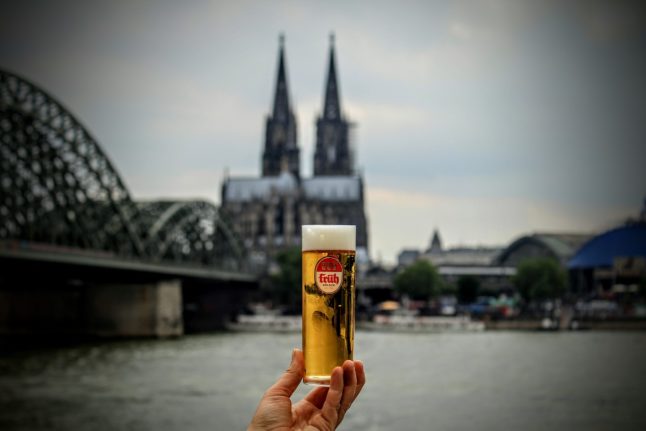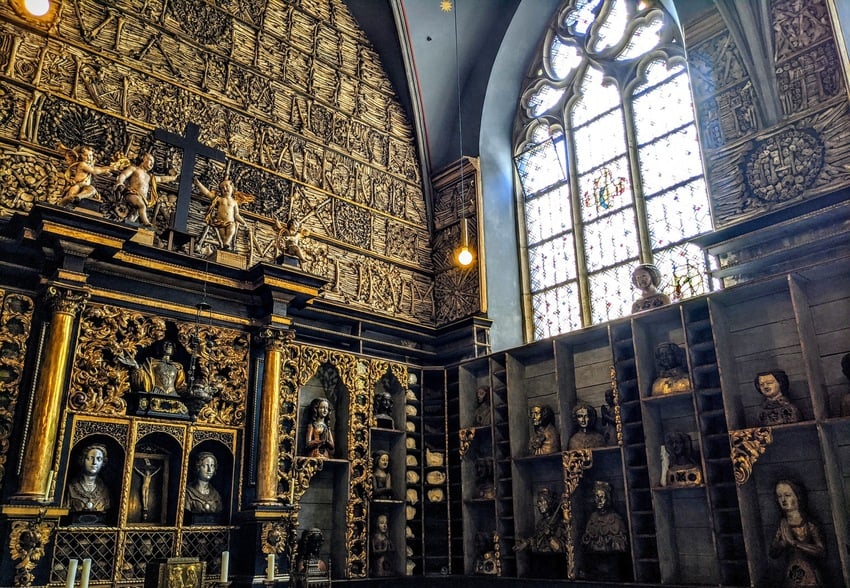In fact, the country has such a wealth of unique and fascinating hotels, hostels and other accommodations that any series listing them could easily extend over several instalments.
However, for those seeking an introduction to how unique German hospitality can be, here are ten unforgettable places to stay across the sixteen federal states.
Zum Roten Bären
Freiburg, Baden-Württemberg
Let’s start at the beginning. No, really.
Zum Roten Bären, located in the heart of the university city of Freiburg am Briesgau, is Germany’s oldest continuously operating hotel. To be precise, 51 landlords have been welcoming guests since 1120. In fact, archaeological excavations have revealed that the building predates the city surrounding it!
Don’t think the age of the place means spartan conditions – Zum Roten Bären hosts a restaurant renowned in the region, and the rooms boast modern comforts while tastefully honouring the heritage of the beloved inn.
Zum Roten Bären is a hotel and restaurant in Freiburg, Germany; claims to be the oldest hotel in Germany and Europe. The foundations of the hotel date back to the founding of the city of Freiburg by the dukes of the House of Zähringen in 1120. pic.twitter.com/OCThsP36h7
— Rogelio Galván 🇩🇪🇲🇽 (@RogelioGalvn2) December 8, 2022
V8 Motorworld Hotels
Böblingen, Baden-Württemberg
The Stuttgart region gave the world the motor car, and this contribution is honoured at the V8 Motorworld Hotels – the Superior and Classic.
Both are part of the enormous Motorworld complex developed on the site of the old Böblingen Airport, where revheads come for tradeshows, swap meets and other automotive-themed events.
Each room in the two hotels is outfitted with beds made from original cars and features art themed around motorsports.
Each hotel also has a restaurant revered throughout the region by local American populations for its offerings, from Tex-Mex to barbecue.
Explore your automotive passion at the V8 Hotel Motorworld Region Stuttgart ~ #Germany pic.twitter.com/EHuF1qee6V
— LTM JETS (@LTMJETS) December 10, 2015
Baumhaus Dörfle
Seelbach, Baden-Württemberg
This one is ideal for those on a Black Forest break. The three treehouses that constitute the Baumhaus Dorfle, part of the Ferienparadies Schwarzwälder Hof holiday park, are warm and cosy, each with a balcony offering a beautiful view of the surrounding forest.
Close to the historic city of Lahr and surrounded by some of Germany’s most outstanding hiking trails, there’s everything required for a relaxation vacation, far from the noise and movement of city life.
🌳Schwarzwälder Hof 🌳BlackForest Germany 🇩🇪holiday paradise is the Baumhaus Dörfle. A total of ten tree houses are grouped here in a village style around a central lookout tower. #Travel #Tuesday #Landscape #Adventure 📹@iloveitalyy @CONTEMPRA_INN🌹pic.twitter.com/0jFAT0NMPA
— ContempraINN🌹 (@CONTEMPRA_INN) October 18, 2022
Hotel Wasserturm
Cologne, North Rhine-Westphalia
Sure, this hotel is built within one of the water towers that used to supply Cologne. Still, Hotel Wasserturm prides itself on offering boutique accommodation and unparalleled views of one of Germany’s oldest cities.
Once you’ve fortified yourself with a cocktail from Bar Botanik, many of the city’s most fantastic attractions, such as the cathedral, are less than a 10-minute walk away.
Hotel im Wasserturm Köln: Luxus im ehemals größten Wasserturm Europashttps://t.co/0kuwXVbZlb pic.twitter.com/6SU9nvilKB
— World Travel News (@worldtravel_de) September 30, 2016
Hotel Adlon
Berlin, Berlin
Infamous as the hotel from which Michael Jackson dangled baby ‘Blanket’, this Berlin icon is so, so much more than that brief event.
The original Hotel Adlon was opened by hotelier Lorenz Adlon in 1907 and became famous across Europe for its luxury furnishings and impeccable hospitality.
The Hotel Adlon was a celebrity watering hole throughout the twenties and early thirties – Marlene Dietrich and Josephine Baker were regular guests. Even the arrival of the Nazis couldn’t dim its light, with many party luminaries spending their evenings there.
Largely destroyed in the dying days of World War II, the hotel managed to operate in part until 1984, even behind the Iron Curtain (only metres away, as the Brandenburg Gate divided the two Berlins).
In 1997 the entire complex was rebuilt and reopened by the Kampinski group and has only thrived since as Berlin booms.
Hotel Adlon – the hotel where Micheal Jackson showed Blanket to the paparazzi. pic.twitter.com/oSW8rcgAlu
— When Batmen Fly (@whenbatmenfly) July 31, 2022
Hotel Gotisches Haus
Rothenburg ob der Tauber, Bavaria
Starting as a food storage house for nearby monks, this unassuming building was rapidly spotlighted in the 15th century.
Holy Roman Emperor Friedrich III and his son, the future Emperor Maximilian I, came to stay for two weeks in 1474 – Friedrich published edicts. He received visitors in the Gotisches Haus while Maximilian partied and enjoyed the local nightlife.
This gave the place a bit of a profile boost, and the building served as the home of several wealthy figures throughout the centuries.
In 1969, as tourism began to take off in the storybook-perfect town, it was purchased and renovated as a boutique hotel.
Now, each of the eleven rooms echoes the grandeur of the 15th-century Holy Roman Empire, albeit with subtle differences in design.
Check out the Historik Hotel Gotisches Haus garni is a restored 13th-century building in the town of Rothenburg ob der Tauber. pic.twitter.com/w1i3mG3jvO
— Paper Pills ريم 📚🇵🇸❤️ (@ReemK10) September 14, 2021
Hüttenpalast
Berlin, Berlin
If the extravagant surroundings of Hotel Adlon aren’t to your liking, but you still want to spend a night in comfort, head to the hipster hotspot of Neukölln, where Hüttenpalast offers caravan stays in a renovated factory.
Each caravan across two halls has been renovated and brought up to provide a comfortable and unique experience for visitors – although they don’t have their own toilets and showers, they’re provided communally.
Still, being a short walk away from trendy Kreuzberg and fifteen minutes away from the action in Alexanderplatz, this quirky hostel offers a typical Berlin experience.
Hüttenpalast in Berlin is definitely a new concept for a boutique hotel….. bringing the outside in! pic.twitter.com/zS7tRafW
— Lucie Titchmarsh (@LucieTitchmarsh) May 18, 2012
Burg Hotel Stolpen
Stolpen, Saxony
Part of the Burg Stolpen complex, Burghotel Stolpen sits on the same basalt protrusion on which the ruined 15th-century castle is situated.
Originally a castle protecting the lands of the Bishops of Meissen, the castle came into the hands of the Dukes of Saxony, where it enters popular myth and legend.
Burg Stolpen was, for over forty years, the prison in which Anna Constantia, Countess of Cosel, was imprisoned by Duke August the Strong between 1716 and her death in 1765.
An intelligent, quick-witted woman, albeit conceited, the Duke’s mistress had ruffled one too many feathers and had tried to interfere in strategic pairings.
Hotel guests can explore the tower in which Ana Constantia was held and learn more about her scandalous life in a small museum.
Luckily, they also have a much wider choice of rooms – and a stunning restaurant in which to dine.
Still, the place can’t have been all that bad. Many legends in the region speak of Ana Constantia never really leaving the castle – she’s been spotted wandering around her former digs, albeit in a less-than-corporeal state.
Burg Stolpen is waar de Saksische keurvorst August de Sterke de gravin van Cosel, de bekendste van zijn 12 maîtresses en moeder van 3 van zijn 354 kinderen, van 1716 tot haar dood in 1765 als staatsvijand opsloot. #bekoeldeliefde pic.twitter.com/6j8hOlzQoF
— Angelique (@KwetterMik) August 4, 2018
Kloster Hornbach
Hornbach, Rhineland-Palatinate
Kloster Hornbach – or Hornbach Abbey – is old. First founded in 741, it was one of the region’s most potent monastic foundations and was a pilgrimage site, for it was where the remains of Saint Pirmin, a Merovingian missionary, were kept. It drew the faithful from hundreds of kilometres around for hundreds of years.
Unfortunately, as with most large institutions so close to the French border, Kloster Hornbach was either raided, burned or used as target practice by the French at several intervals over the centuries, despite efforts to maintain a school on the grounds after the monastery closed in the 16th century.
In the early 21st century, the abbey buildings were turned into a hotel, Hotel Kloster Hornbach, meant to evoke the peace and tranquillity of the monastic lifestyle – albeit with everything you’d want from a modern boutique hotel.
After touring the local vineyards, playing golf, and perhaps straying across the border into France, visit the Abbey Museum. There, you can learn about several locals, including Hieronymous Bock, who has been called ‘the Father of Botany’.
Im #Hotel Kloster Hornbach in der #Südwestpfalz bei Zweibrücken nahe der französischen Grenze ist die Neugestaltung beendet 🍾 Die Zimmer und Suiten, der historische Kreuzgang mit Rezeption und Lobby und der Innenhof sprühen nun vor modernem Charme!
© Hotel Kloster Hornbach pic.twitter.com/ey21fVcAfh
— Food and Travel Germany (@foodandtravelde) June 13, 2023
Brauerei Fassla
Bamberg, Bavaria
You didn’t think we’d get through this list without a beer-themed hotel, did you?
With a UNESCO-protected Old Town unsurpassed in its preserved state, Bamberg was also once home to more breweries than almost anywhere else in the former Holy Roman Empire.
It’s mainly well known for Rauchbier – smoked beer. It’s an acquired taste but quickly addictive.
Here’s one thing they need to tell you about many of Bamberg’s breweries: they offer room for travellers.
While less luxurious than many hotels, they’re very comfortable, clean, and great value. Best of all, you’re close to the action.
Brauerei Fassla offers rooms and is close to all the city’s attractions. Of course, it also has a brewpub and a restaurant where you can recharge after a long day of sightseeing. You can rest assured of the quality too – these guys have been doing their thing since 1649!
So the dominant building I can see out of my Spezial Brewery room is a brewery, Fassla. Only in Bamberg. pic.twitter.com/mQOq7ipjmh
— Surrey Hills Brewery (@SurreyHillsBrew) July 22, 2015
Do you have any recommendations for unforgettable stays in Germany? Let us know in the comments!






 Please whitelist us to continue reading.
Please whitelist us to continue reading.
Member comments